Posts Tagged ‘Slave Housing’
Sunday, June 13th, 2010
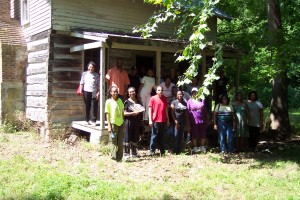
In addition to touring the grounds surrounding the Wessyngton mansion, National Black Arts Festival members and guests walked in the footsteps of Baker’s ancestor in the slave cabin area of the plantation. The group went inside a restored slave cabin built ca. 1830. In 1860, there were 274 enslaved African Americans on the plantation, housed in forty log cabins. At the onset of the Civil War, Wessyngton held the largest African American population in the state of Tennessee and was the largest tobacco producer in America.
Tags:African History, Antebellum Plantation, black history, Civil War, Dr. Collette Hopkins, National Black Arts Festival, plantation slavery, Plantations, Slave cabins, Slave Housing, Slave Labor, Slave Life, Southern Plantation, Tennessee slavery, Wessyngton mansion
Posted in Book Tour & Reviews, Civil War, Current Events, Genealogy & DNA, Interviews, Introduction & Personal, Plantation Life, Research | Comments Closed
Friday, November 6th, 2009
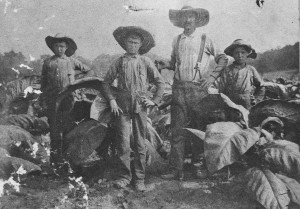
White Sharecroppers on Wessyngton Plantation
After the Civil War several former Wessyngton slaves remained on the plantation. Others moved to Nashville, to the north, surrounding counties and some purchased their own farms.
When the former slaves left the area many white farmers and African Americans came to Wessyngton Plantation and became sharecroppers and resided in the former slave cabins.
Under the sharecropping system, the landowner received two thirds of the crop and the tenant or sharecropper only received one third of the crop. The sharecropper was provided a house, mules, land, seed and fetilizer. They raised crops of tobacco, corn, wheat and rye.
African American and white sharecroppers continued farming on Wessyngton Plantation until the property was sold by the Washington family in 1983 nearly 200 years after the plantation was founded.
Tags:Add new tag, Plantation, Sharecrop, Sharecropping, Slave cabins, Slave Housing, Tenant Farmers, Tenant Housing, Tobacco Production
Posted in Civil War, Genealogy & DNA, Interviews, Plantation Life, Research | Comments Closed
Monday, November 2nd, 2009
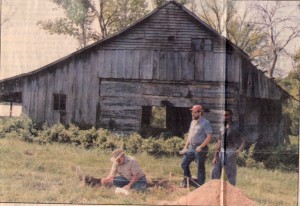
Archaeological Dig at Wessyngton Slave Cabin Site
In 1991, I had an opportunity that few historians or genealogists ever have; to literally walk in your ancestors’ footsteps. In 1989 I was approached by the president of the Bloomington-Normal black history Project and director of the Midwestern archaeological research Center, about the potential investigations of the salve cabin area on Wessyngton Plantation to get an interpretation of slave life there. Similar digs have been conducted at the Hermitage, Mt. Vernon, and Monticello.
The actual digging at Wessyngton did not start until 1991. The thought of actually walking in my ancestors’ footsteps and holding objects they used in their everyday lives one hundred years earlier was surreal to me. Three sections of the slave cabin area were selected for exploration. One site was where the cabin of my great-great-grandparents Emanuel and Henny Washington once stood.
The dig yielded fragments of pottery and dishes used by my ancestors as well as coins and arrowheads made by Native Americans.
The photograph above shows the site of the archaeological dig on Wessyngton Plantation where my ancestors once lived.
Tags:African American History, African Slavery, Arrowheads, black history, Black History Month, Civil War, Monticello, Mt. Vernon, Native Americans, Plantation Archaeology, plantation slavery, Slave Cabin, Slave Housing, Slave Life, Tennessee slavery, The Hermitage
Posted in Civil War, Genealogy & DNA, Interviews, Introduction & Personal, Plantation Life, Research | Comments Closed
Monday, October 5th, 2009
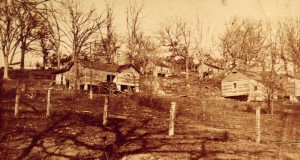
Wessyngton Slave Cabins
Housing for slaves varied from plantation to plantation depending on the owners. Most slave quarters were generally arranged in avenues or streets and located behind the mansion or ‘Big House.’ They were strategically placed to give the owner or overseer a clear view of the slaves, so their activities could be easily monitored.
The slave settlement at Wessyngton Plantation, however, did not fit this pattern. The lack of a clustered settlement pattern at Wessyngton was somewhat unusual during antebellum times. This was primarily due to the hilly topography of the plantation. The scattered pattern gave the slaves at Wessyngton more freedom and made it far more difficult to keep them under constant surveillance.
Typically, slave housing at Wessyngton consisted of hand-hewn one-room log cabins measuring 20 by 20 square feet with brick end chimneys. Some cabins were 18 by 36 square feet. Each cabin had log flooring and a loft, where children slept.
Each cabin housed an average of six individuals. Family sizes varied depending on the number births, deaths and marriages.
Tags:African American Family Life in Slavery, African Slavery, Antebellum Mansion, Antebellum Plantation, Big House, Civil War, Great House, Log Cabin, Log Housing, Overseer, Slave cabins, Slave Family, Slave Houses, Slave Housing, Slave Plantation
Posted in Civil War, Genealogy & DNA, Interviews, Introduction & Personal, Plantation Life, Research | Comments Closed
Monday, July 13th, 2009
Check out my article on BlackPast.org. It is an excellent resource for African American history and genealogy.
Tags:African American Resources, From Slavery to Freedom, Genealogy & DNA, George Washington, Mt. Vernon, Plantation Life, Slave cabins, Slave Community, Slave Housing, Slave Life, Slavery to Freedom, Southern Plantations, Tennessee Plantations, Washington family, Wessyngton Plantation
Posted in Book Tour & Reviews, Current Events, Genealogy & DNA, Interviews, Introduction & Personal, Plantation Life, Research | Comments Closed
Sunday, July 12th, 2009
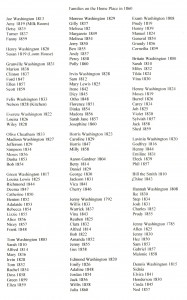
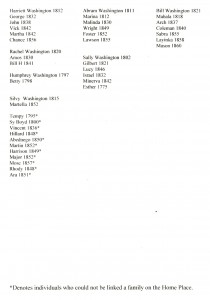
In 1860 Wessyngton Plantation was the largest tobacco plantation in the United States. The Washington family also held the largest number of enslaved African Americans (274) in the state of Tennessee. 187 of them were held on what was called the “Home Place” near the Wessyngton mansion. Eighty-seven others were held on a part of the plantation known was the “Dortch Place.”
Tags:African American Family Life in Slavery, Antebellum Plantation, Dortch Place, Emancipation, Emancipation Proclamation, Home Place, Slave Cabin, Slave Cemetery, Slave Family, Slave Housing, Slave Surnames, Slave Women, Tennessee Plantations, Tennessee slavery, Tobacco, tobacco plantation, Washington family
Posted in Civil War, Genealogy & DNA, Interviews, Introduction & Personal, Plantation Life, Research | Comments Closed





